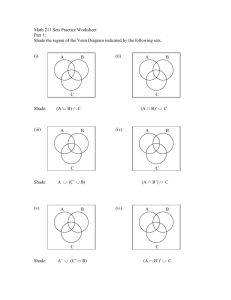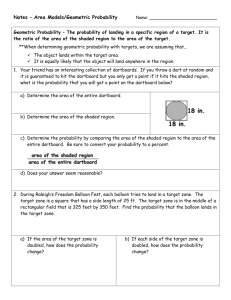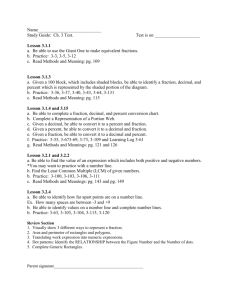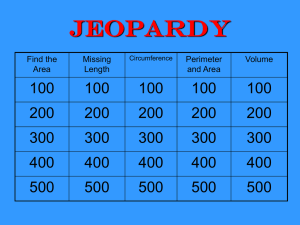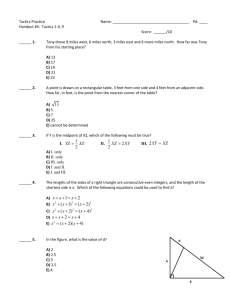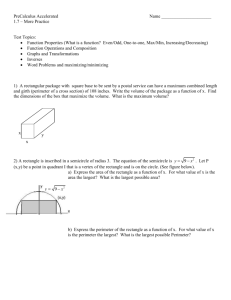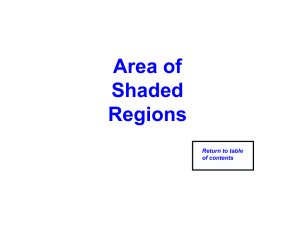Worksheet: Year 7 - Area & Perimeter exercises
advertisement
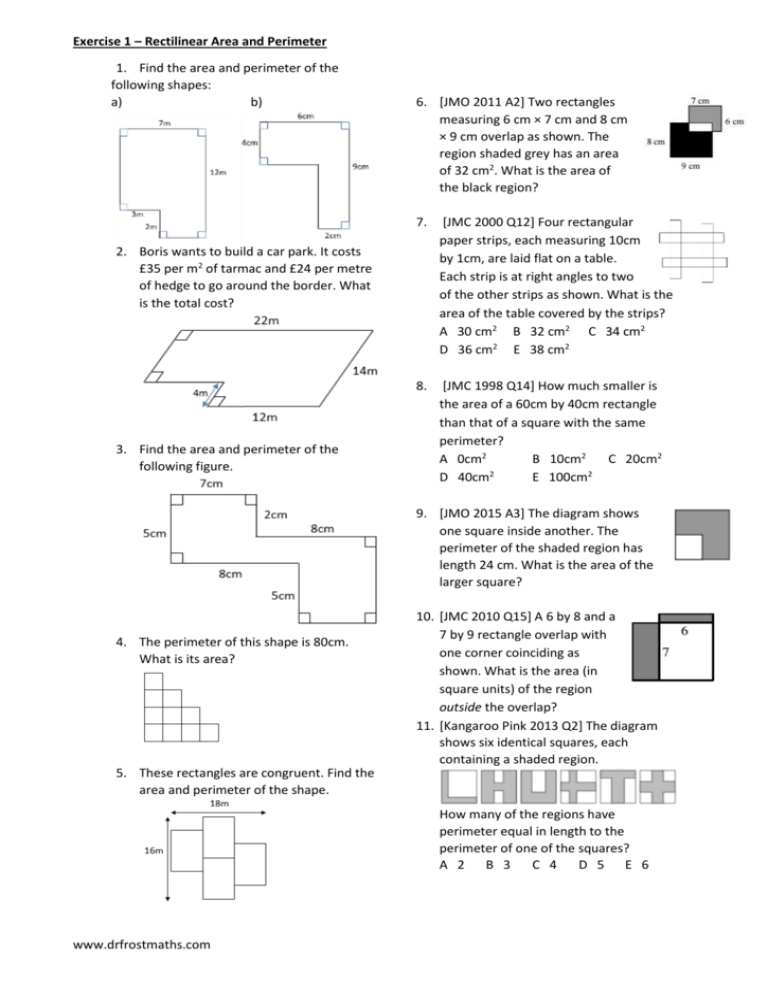
Exercise 1 – Rectilinear Area and Perimeter 1. Find the area and perimeter of the following shapes: a) b) 6. [JMO 2011 A2] Two rectangles measuring 6 cm × 7 cm and 8 cm × 9 cm overlap as shown. The region shaded grey has an area of 32 cm2. What is the area of the black region? 7. [JMC 2000 Q12] Four rectangular paper strips, each measuring 10cm by 1cm, are laid flat on a table. Each strip is at right angles to two of the other strips as shown. What is the area of the table covered by the strips? A 30 cm2 B 32 cm2 C 34 cm2 D 36 cm2 E 38 cm2 8. [JMC 1998 Q14] How much smaller is the area of a 60cm by 40cm rectangle than that of a square with the same perimeter? A 0cm2 B 10cm2 C 20cm2 2 2 D 40cm E 100cm 2. Boris wants to build a car park. It costs £35 per m2 of tarmac and £24 per metre of hedge to go around the border. What is the total cost? 3. Find the area and perimeter of the following figure. 9. [JMO 2015 A3] The diagram shows one square inside another. The perimeter of the shaded region has length 24 cm. What is the area of the larger square? 4. The perimeter of this shape is 80cm. What is its area? 10. [JMC 2010 Q15] A 6 by 8 and a 7 by 9 rectangle overlap with one corner coinciding as shown. What is the area (in square units) of the region outside the overlap? 11. [Kangaroo Pink 2013 Q2] The diagram shows six identical squares, each containing a shaded region. 5. These rectangles are congruent. Find the area and perimeter of the shape. How many of the regions have perimeter equal in length to the perimeter of one of the squares? A 2 B 3 C 4 D 5 E 6 www.drfrostmaths.com 12. [Junior Kangaroo 2015 Q15] A rectangular garden is surrounded by a path of constant width. The perimeter of the garden is 24 m shorter than the distance along the outside edge of the path. What is the width of the path? 13. [JMC 2004 Q24] Five identical rectangles fit together as shown. What, in cm2, is the total area which they cover? 14. [JMC 2013 Q24] Three congruent squares overlap as shown. The areas of the three overlapping sections are 2 cm2, 5 cm2 and 8 cm2 respectively. The total area of the non-overlapping parts of the squares is 117 cm2. What is the sidelength of each square? (Hint: make the area of a square 𝑥 then consider what the area of the non-overlapping part would be in terms of 𝑥) 15. [Kangaroo Grey 2014 Q11] Five equal rectangles are placed inside a square with side 24 cm, as shown in the diagram. What is the area in cm2 of one rectangle? 16. [Kangaroo Grey 2011 Q14] A square piece of paper is cut into six rectangular pieces as shown in the diagram. When the lengths of the perimeters of the six rectangular pieces are added together, the result is 120 cm. What is the area of the square piece of paper? A 48cm2 B 64cm2 C 110.25cm2 D 144cm2 E 256cm2 www.drfrostmaths.com 17. [JMC 2001 Q25] The diagram shows four overlapping squares which have sides 5, 7, 9 and 11. What is the difference between the total area shaded grey and the total area shaded black? A 25 B 36 C 49 D 64 E more information needed 18. [JMC 2008 Q25] A large square is divided into adjacent pairs of smaller squares with integer sides, as shown in the diagram (which is not drawn to scale). Each size of smaller square occurs only twice. The shaded square has sides of length 10. What is the area of the large square? A 1024 B 1089 C 1156 D 1296 E 1444 19. [Kangaroo Grey 2011 Q21] The diagram on the right shows a square with side 3 cm inside a square with side 7 cm and another square with side 5 cm which intersects the first two squares. What is the difference between the area of the black region and the total area of the grey regions? A 0cm2 B 10cm2 C 2 2 11cm D 15cm E more information needed 20. [Maclaurin 2006 Q4] The nonagon shown shaded in the diagram has been made by removing three pieces from an equilateral triangle of side 12. All nine edges of the nonagon are parallel to sides of the triangle. Three edges have lengths 1, 2 and 3 as shown. Calculate the length of the perimeter of the nonagon. Exercise 2 – Triangles, Trapeziums and Parallelograms 1. Find the area of the following shapes. a) b) 5. Bob has a garden in the shape of a trapezium. If it costs £15.22 per m2 of turf, how much will it cost to turf his garden? 6. [IMC 2005 Q9] Which of the following shaded regions has an area different from the other shaded regions? c) d) f) [SMC 2003 Q2] Triangle 𝑃𝑄𝑈 has a right angle at 𝑈. The points 𝑅, 𝑆 and 𝑇 divide the side 𝑄𝑈 into quarters. Which of the following statements about the areas of the triangles 𝑃𝑄𝑅, 𝑃𝑅𝑆, 𝑃𝑆𝑇, 𝑃𝑇𝑈 is true? A All have the same area B Δ𝑃𝑄𝑅 is biggest C Δ𝑃𝑅𝑆 is biggest D Δ𝑃𝑆𝑇 is biggest E Δ𝑃𝑇𝑈 is biggest h) 8. If 𝐴𝐵 = 9cm, 𝐴𝐶 = 6𝑐𝑚, 𝐷 is a point such that 𝐶𝐷 is perpendicular to 𝐴𝐵 and 𝐶𝐷 = 4𝑐𝑚, 𝐸 is a point such that 𝐴𝐶 is perpendicular to 𝐵𝐸, then what is the length of 𝐵𝐸? 7. e) g) 2. If the area is 50cm2 and the base 20cm, what is the perpendicular height? 3. [JMC 2014 Q9] Triangles 𝑋𝑌𝑍 and 𝑃𝑄𝑅 are drawn on a square grid. What fraction of the area of triangle 𝑋𝑌𝑍 is the area of triangle 𝑃𝑄𝑅? 4. [JMC 2009 Q6] Each square in the figure is 1 unit by 1 unit. What is the area of triangle 𝐴𝐵𝑀 (in square units)? A 4 B 4.5 C 5 D 5.5 E 6 www.drfrostmaths.com 9. In the diagram, 𝐴𝐵 = 𝐴𝐷 = 𝐴𝐸 and 𝐵𝐷 = 10cm. Determine the length 𝐵𝐸, leaving your answer as a fraction. 10. The area of this parallelogram is 51cm2. Determine 𝑎. Exercise 3 – Area and Circumference of Circles 1. Find the area and circumference of the following circles, giving your answer to 1 decimal place. a) b) c) Exercise 4 – Fractions of Circles 1. Find the area and perimeter of the following shapes, giving your answer to 1 decimal place. a) b) d) c) 2. Find the area and circumference, giving your answers in exact form. a) b) 3. A car wheel of diameter 35cm spins on a road. Over 2000cm, how many full rotations will the wheel have made? 4. A circular lawn has radius 50m. Each box of grass seed costs £5.99 and covers 60m2 of lawn. What is the cost to seed the whole lawn? 5. The radius of the Earth is 6371km. Light can travel 300,000km each second. How many times can light encircle the Earth in a second? 6. The area of a circular disc is 100cm2. What is its diameter? As the radius 𝑟 of a circle increases, which graph shows how (a) the circumference increases and (b) the area increases? www.drfrostmaths.com d) 2. Find the area and perimeter of the following, giving exact answers. a) b) 3. Find the area and perimeter of the following, giving exact answers. a) b) 4. Fred Flintstone’s car has two different wheels: one circular in shape and the other semicircular. The diameter of the semicircular wheel is 1.3m. What radius is needed for the circular wheel so that the wheels make the same number of full circulations over any journey? (Give your answer to 3 decimal places) Exercise 5 – Adding, Subtracting and Reforming Areas 1. Find the exact area of the following shapes. a) b) c) 4. [JMO 2008 A10] The perimeter of the shape shown on the right is made from 20 quartercircles, each with radius 2 cm. What is the area of the shape? (Hint: once you cut up and reform, what two simple shapes are you left with?) d) [IMC 1997 Q17] The point 𝑂 is the centre of a circle of radius 1 unit, 𝑂𝐴, 𝑂𝐶 are radii, and 𝑂𝐴𝐵𝐶 is a square. What is the area of the shaded region (in square units)? 6. [IMC 2009 Q13] The diagram on the right shows a rectangle with sides of length 5cm and 4cm. All the arcs are quarter-circles of radius 2cm. What is the total shaded area in cm2? A 12 − 2𝜋 B 8 C 8 + 2𝜋 D 10 E 20 − 4𝜋 5. e) f) 2. If these grids are unit (1cm) width/height, determine the area of the triangles. a) b) 7. [IMC 2012 Q19] The shaded region shown in the diagram is bounded by four arcs, each of the same radius as that of the surrounding circle. What fraction of the surrounding circle is shaded? A D c) d) 9𝜋 2 C 4𝜋 www.drfrostmaths.com −1 𝜋 B 1−4 C 1 2 E it depends on the radius 8. [STMC Regional 2007/08 Q5] The square in the diagram below has sides of length two units. The shaded sections are enclosed by 4 semi-circles. Calculate the exact value of the total area of the unshaded regions. 3. [JMC 2007 Q19] The points 𝑃, 𝑄, 𝑅, 𝑆 lie in order along a straight line, with 𝑃𝑄 = 𝑄𝑅 = 𝑅𝑆 = 2 cm. Semicircles with diameters 𝑃𝑄, 𝑄𝑅, 𝑅𝑆 and 𝑆𝑃 join to make the shape shown on the right. What in cm2, is the area of the shape? A 5𝜋 B 4 𝜋 1 3 D 7𝜋/2 E 3𝜋 [Based on Hamilton 2010 Q4] The diagram shows a quarter-circle with centre O and two semicircular arcs with diameters OA and OB. Let 𝑂𝐴 = 1. Calculate the difference between the area of the region shaded grey and the area of the region shaded black. 9 20 9 16 3 7 3 5 1 2 Exercise 6 - Fractions of Shapes A Test Your Understanding: [JMC 2012 Q22] The diagram shows a design formed by drawing six lines in a regular hexagon. The lines divide each edge of the hexagon into three equal parts. What fraction of the hexagon is shaded? Question 4: [JMC 2001 Q9] In the diagram, a corner of the shaded star is at the midpoint of each side of the large square. What fraction of the large square is covered by the star? A 1 5 2 B9 1 C4 D 3 10 5 16 E By considering what fraction the shaded triangle’s base and height is of the larger triangle, work out the fraction of the shape shaded. Fraction of width = Fraction of (perpendicular) height = Overall fraction = [SMC 2003 Q21] The outer equilateral triangle has area 1. The points 𝐴, 𝐵, 𝐶 are a quarter of the way along the sides as shown. What is the area of the equilateral triangle 𝐴𝐵𝐶? A 3 8 B 7 16 C 1 2 D 9 16 E A 1 5 B B 1 4 C C D 1 3 D 3 8 E E 2 5 Question 5: [JMC 2015 Q22] The diagram shows a shaded region inside a regular hexagon. The shaded region is divided into equilateral triangles. What fraction of the area of the hexagon is shaded? A 3 8 B 2 5 C 3 7 D 5 12 E 1 2 Question 6: Determine the fraction of each square each region within it is. (e.g. the top-left 1 4 region of the square is of the square) 5 8 Question 1: [IMC 2011 Q18] The diagram contains six equilateral triangles with sides of length 2 and a regular hexagon with sides of length 1. What fraction of the whole shape is shaded? A 1 8 B 1 7 C 1 6 D 1 5 E 1 4 Question 2: [JMC 2006 Q16] The diagram shows an equilateral triangle with its corners at the mid-points of alternate sides of a regular hexagon. What fraction of the area of the hexagon is shaded? A 1 2 B 1 3 C 3 8 D 4 9 Question 3: [JMC 2007 Q5] In the diagram, the small squares are all the same size. What fraction of the large square is shaded? www.drfrostmaths.com E 7 12 Question 7: [JMO 1999 A10] What fraction of the whole square is occupied by the shaded square? Question 8: [IMC 2004 Q25] The diagram shows a square with two lines from a corner to the middle of an opposite side. The rectangle fits exactly inside these two lines and the square itself. What fraction of the square is occupied by the shaded rectangle? A 1 3 B 2 5 C 3 10 D 1 2 E 3 8 Question 9: [IMC 2012 Q25] The diagram shows a ceramic design by the Catalan architect Antoni Gaudi. It is formed by drawing eight lines connecting points which divide the edges of the outer regular octagon into three equal parts, as shown. What fraction of the octagon is shaded? A 1 5 B 2 9 C 1 4 D 3 10 E 5 16 Question 10: [IMC 2015 Q25] A point is marked one quarter of the way along each side of a triangle, as shown. What fraction of the area of the triangle is shaded? A 7 16 B 1 2 C 9 16 D 5 8 E 11 16 Question 11: The diagram shows a square ABCD of side 10 units. Line segments AP, AQ, AR and AS divide the square into five regions of equal area, as shown. What is the length of 𝑄𝐶? Question 1: [JMO 2008 B5] In the diagram, the rectangle ABCD is divided into three congruent rectangles. The line segment JK divides CDFG into two parts of equal area. What is the area of triangle AEI as a fraction of the area of ABCD? (Note: This question is a ‘B section’ Junior Maths Olympiad problem, so ordinarily, when in the actual JMO exam, you’d be expected to justify why you were able to break up the shape in the way you did, using worded explanation. Just stating the answer and showing lines in the diagram wouldn’t be sufficient for full marks) www.drfrostmaths.com Question 2: [SMC 2011 Q16] 𝑃𝑄𝑅𝑆 is a rectangle. The area of triangle 𝑄𝑅𝑇 1 5 is of the area of 𝑃𝑄𝑅𝑆, and the 1 8 area of triangle 𝑇𝑆𝑈 is of the area of 𝑃𝑄𝑅𝑆. What fraction of the area 𝑃𝑄𝑅𝑆 is the area of triangle 𝑄𝑇𝑈? A 27 40 B 21 40 C 1 2 D 19 40 E 23 60 Question 3: [IMOK 2013 Solutions Back Cover] This shape spirals inwards infinitely. What fraction of the shape is shaded?

